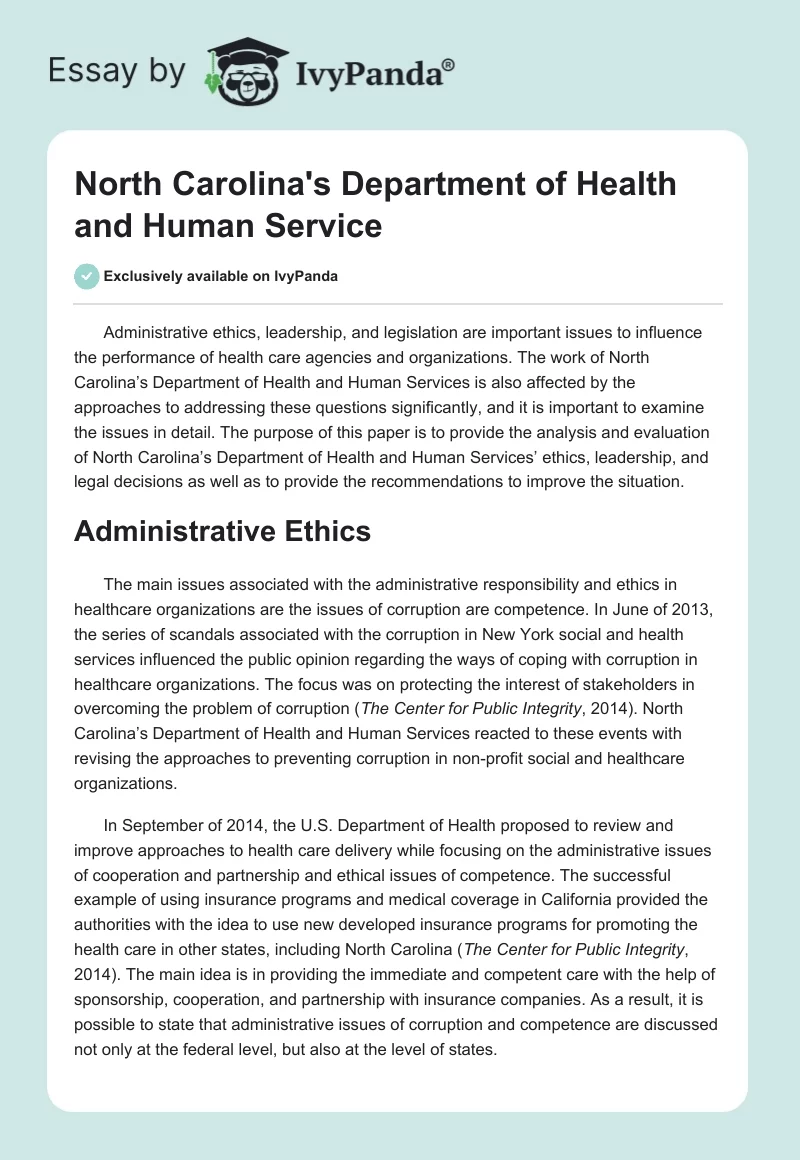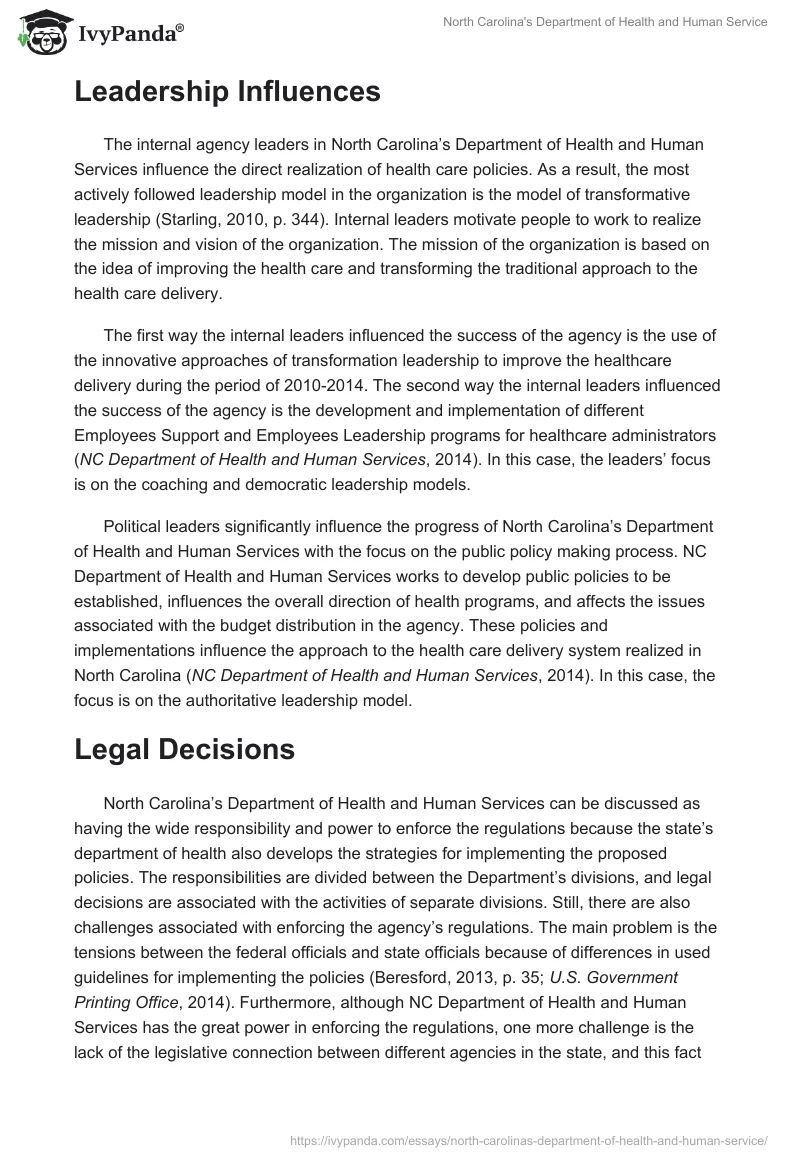Administrative ethics, leadership, and legislation are important issues to influence the performance of health care agencies and organizations. The work of North Carolina’s Department of Health and Human Services is also affected by the approaches to addressing these questions significantly, and it is important to examine the issues in detail. The purpose of this paper is to provide the analysis and evaluation of North Carolina’s Department of Health and Human Services’ ethics, leadership, and legal decisions as well as to provide the recommendations to improve the situation.
Administrative Ethics
The main issues associated with the administrative responsibility and ethics in healthcare organizations are the issues of corruption are competence. In June of 2013, the series of scandals associated with the corruption in New York social and health services influenced the public opinion regarding the ways of coping with corruption in healthcare organizations. The focus was on protecting the interest of stakeholders in overcoming the problem of corruption (The Center for Public Integrity, 2014). North Carolina’s Department of Health and Human Services reacted to these events with revising the approaches to preventing corruption in non-profit social and healthcare organizations.
In September of 2014, the U.S. Department of Health proposed to review and improve approaches to health care delivery while focusing on the administrative issues of cooperation and partnership and ethical issues of competence. The successful example of using insurance programs and medical coverage in California provided the authorities with the idea to use new developed insurance programs for promoting the health care in other states, including North Carolina (The Center for Public Integrity, 2014). The main idea is in providing the immediate and competent care with the help of sponsorship, cooperation, and partnership with insurance companies. As a result, it is possible to state that administrative issues of corruption and competence are discussed not only at the federal level, but also at the level of states.
Leadership Influences
The internal agency leaders in North Carolina’s Department of Health and Human Services influence the direct realization of health care policies. As a result, the most actively followed leadership model in the organization is the model of transformative leadership (Starling, 2010, p. 344). Internal leaders motivate people to work to realize the mission and vision of the organization. The mission of the organization is based on the idea of improving the health care and transforming the traditional approach to the health care delivery.
The first way the internal leaders influenced the success of the agency is the use of the innovative approaches of transformation leadership to improve the healthcare delivery during the period of 2010-2014. The second way the internal leaders influenced the success of the agency is the development and implementation of different Employees Support and Employees Leadership programs for healthcare administrators (NC Department of Health and Human Services, 2014). In this case, the leaders’ focus is on the coaching and democratic leadership models.
Political leaders significantly influence the progress of North Carolina’s Department of Health and Human Services with the focus on the public policy making process. NC Department of Health and Human Services works to develop public policies to be established, influences the overall direction of health programs, and affects the issues associated with the budget distribution in the agency. These policies and implementations influence the approach to the health care delivery system realized in North Carolina (NC Department of Health and Human Services, 2014). In this case, the focus is on the authoritative leadership model.
Legal Decisions
North Carolina’s Department of Health and Human Services can be discussed as having the wide responsibility and power to enforce the regulations because the state’s department of health also develops the strategies for implementing the proposed policies. The responsibilities are divided between the Department’s divisions, and legal decisions are associated with the activities of separate divisions. Still, there are also challenges associated with enforcing the agency’s regulations. The main problem is the tensions between the federal officials and state officials because of differences in used guidelines for implementing the policies (Beresford, 2013, p. 35; U.S. Government Printing Office, 2014). Furthermore, although NC Department of Health and Human Services has the great power in enforcing the regulations, one more challenge is the lack of the legislative connection between different agencies in the state, and this fact influences the realization of legal decisions regarding the implementation of health care policies.
Strategies for Consideration to Administrative Processes
In order to improve the agency’s operation, the internal leaders focus on the development of cooperation strategies and the development of partnerships with NC Department of Employment and Department of Occupational Safety. The next strategy is the promotion of leadership policies within the organization in order to develop the employees’ leadership traits with the focus on Leadership DHHS program which is at the first stage of the development. The third strategy is associated with the improvement of the agency’s approach to realizing the principles of the administrative ethics (Appendix 1). The focus is on improving the ethical approach and issues regarding the compensation provided for stakeholders who are affected by incompetent actions of healthcare administrators. NC Department of Health and Human Services plans to review the approach to the ethical decision making with the focus on the rights ethics, which is in contrast to the previously followed ethics of obligation to formal principles.
Recommendations for Improvements to Administrative Processes
The strategies that can provide the immediate improvement for the agency’s policies are the following ones:
- Following the Political Systems model, it is possible to recommend the improvement of the ethical principles followed in the organization to promote the performance.
- Following the Policy Process model, it is important to recommend the strategy which includes several steps, and which is based on improvement of the cooperation between the divisions of NC Department of Health and Human Services with the focus on the careful analysis of the demand in relation to the public health, the development of the cooperative team to respond to the demand, and the development of the task enforcing team.
It is also important to address the agencies’ plans in the developed recommendations:
- To create partnerships with NC Department of Employment and Department of Occupational Safety, it is necessary to propose the strategy meeting the goals of both agencies.
- To benefit from the Leadership DHHS program, it is necessary to propose the plan of actions for employees, including motivation and training aspects.
- To improve the ethical decision making, it is necessary to revise the code of ethics followed in the organization.
Conclusion
North Carolina’s Department of Health and Human Services can be discussed as developing the effective administration. However, there are several challenges associated with the work of the department’s divisions. Changes in the administrative activities of different organizations influence how the public and other institutions discuss the effectiveness of their own strategies. Thus, NC Department of Health and Human Services should focus on implementing a range of proposed strategies to improve administration with the focus on the provided recommendations.
References
Beresford, H. R. (2013). Legal process, litigation, and judicial decisions. HCN, 118(2), 35-61.
NC Department of Health and Human Services. (2014). Web.
Starling, G. (2010). Manage the public sector. New York, NY: Cengage Learning.
The Center for Public Integrity. (2014). Web.
U.S. Government Printing Office. (2014). Web.


